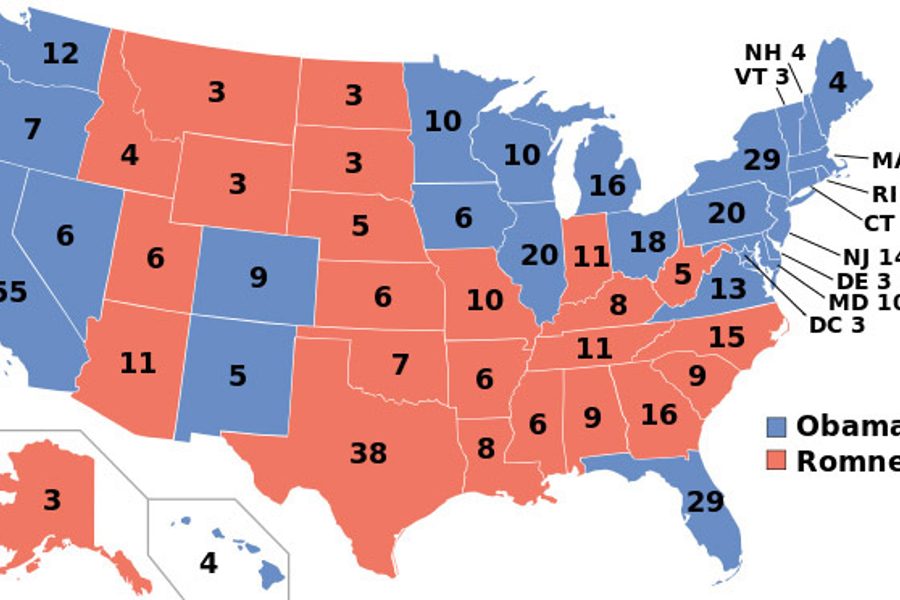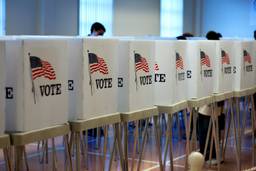
As partisans sift through data from the 2012 presidential elections, the impact of our current Electoral College rules is getting particular scrutiny, as is the potential impact of changing those rules before the 2016 election.
Given that the Constitution gives states plenary authority over how to allocate their electors, considering changes to those rules is not an idle question. Even eliminating elections entirely and having the legislature appoint electors would be entirely legal. I firmly believe our leaders will embrace the right solution: adoption of the National Popular Vote plan in enough states for it to become active by 2016 and, as a result, guarantee that the White House goes to the candidate with the most popular votes in all 50 states and D.C.
But partisan approaches can be tempting. Republicans, having had this election within grasp only to soundly lose it, and observing the Democratic advantage under the current winner-take-all rules, seem particularly ready to explore “creative” changes.
A little number-crunching explains why. If Republicans in 2011 had abused their monopoly control of state government in several key swing states and passed new laws for allocating electoral votes, the exact same votes cast in the exact same way in the 2012 election would have converted Barack Obama’s advantage of nearly five million popular votes and 126 electoral votes into a resounding Electoral College defeat.
The power of elector-allocation rule changes goes further. Taken to an extreme, these Republican-run states have the ability to lock Democrats out of a chance of victory in 2016 absent the Democratic nominee winning a national landslide of some 12 million votes. In short, the Republicans could win the 2016 election by state law changes made in 2013.
I’ll walk through a few scenarios that Republican strategists may be considering. It’s all predicated, of course, on something I fervently hope isn’t true: that Republicans in these six key states would be willing to ignore the large majority of voters who prefer a level playing field in our elections — an attitude we call on all elected officials to reject with our Stand with Voters pledge. Unfortunately, both Republicans and Democrats aren’t shy about ignoring fairness when it suits them — from drawing outlandishly gerrymandered legislative maps, to seeking to block inconvenient third party candidates from the ballot, to changing U.S. Senate vacancy laws based on whichever party holds the governor’s seat.
But it’s hard to beat the potential for corrupting our electoral process that must tempt Republicans today. Essentially, they can rig the next presidential election. Here’s a series of scenarios of what various rule changes would do for Republican Electoral College chances in 2016.
Pennsylvania’s proportional representation proposal
As I explained last week, Pennsylvania Senate Majority Leader Dominic Pileggi is planning to introduce a bill to replace the winner-take-all allocation of his state’s Electoral College votes with a plan in which two electoral votes would go to the winner of the state and 18 votes would be allocated based on proportional representation — meaning a presidential candidate receiving 33 percent of the vote would win six of 18 electoral votes.
As expected, the proposal has drawn strong partisan reactions, with state Democratic Party chair Jim Burn posting on his party’s blog: “This is the ultimate sour grapes. After getting swept in statewide elections, Pennsylvania Republicans are trying to change the rules to help Republican politicians.” The partisan angle derives from the fact that Pennsylvania Republicans often come close in presidential elections, but their nominee hasn’t carried the state since 1988. If Sen. Pileggi’s plan had been in place this year, President Barack Obama’s 5.4 percent win in the state’s popular vote would not have translated into 20 electoral votes for winning the state, but only 12 electoral votes.
Shifting eight electoral votes from one candidate to another is a big deal. Consider that one of the most actively wooed states this year was Iowa, which attracted 27 presidential and vice-presidential nominee campaign events in the post-conventions general election period, more than all but three other states. Yet Iowa has a total of only six electoral votes.
But Sen. Pileggi’s proposal is far from enough to ensure that Republicans win the 2016 presidential race. This year, Pennsylvania using that system wouldn’t have changed the outcome even if Republicans had swept every state where Barack Obama’s winning percentage trailed his national average — that is, the Obama-won states that most likely would have gone to Romney if the candidates had been even in the national popular vote. Under this scenario, Romney would have earned all 29 electoral votes from Florida, all 18 votes from Ohio and likely nine from Pennsylvania. That would have boosted Romney from 206 electoral votes to 262 votes — still seven electoral votes short of a tie and eight away from a straight win, meaning he would have needed to win another state where Obama outperformed his national average, such as Colorado.
The potential of collusion
Pennsylvania doesn’t need to act alone. In the last year, Republican leaders have indicated interest in dividing electoral votes in such states as Wisconsin, Michigan, Ohio and, just this week, Virginia, where state senator Bill Carrico has introduced a bill to allocate Virginia’s electoral votes by congressional district. We’ll get to Sen. Carrico’s plan more below, as it gives more advantage to Republicans than any other plan short of simply going back to the days of legislatures appointing electors.
For the purposes of speculation, let’s imagine the following six states colluding to change Electoral College allocation rules: Florida, Michigan, Ohio, Pennsylvania, Virginia and Wisconsin. These states all have Republican governors and Republican-run state legislatures. And while they are among the 12 states that earned attention from the presidential campaigns this fall, all six states gave every one of their electoral votes to Barack Obama in the 2012 election.
In our analysis, keep in mind that any measure to divide a state’s electoral votes guarantees that both parties will always earn at least some electors. Doing so can boost a Republican when a Democrat wins a state, but help a Democrat when a Republican wins the state. So it could be self-defeating for the Republicans to divide electors in states likely to lean their way in a nationally even election — states like Florida and Ohio. But in certain contexts such a strategy can also help, as we soon will see.
Electoral College Scenarios: FairVote’s Summary of Allocation Methods
The summary table below (and linked as a pdf here) shows how different Electoral College allocation methods would have affected the 2012 presidential election and provides a window into the likely impact of their adoption in these states before 2016.

Our analysis is predicated on all other states keeping their current, mostly winner-take-all rules, but that is a very safe assumption. The remaining states have state governments in alignment with the party that is favored to win that state’s presidential vote in 2016 — meaning that one of these states would likely only change its rules through a ballot measure, as indeed was proposed by some leading Republicans in 2007 in California and was actively pursued by some Democrats in Colorado in 2004.
Furthermore, Democrats have almost no chance to win monopoly control of any of the 23 strongly Republican states any time soon. Where they have a slim chance of doing so — as in Montana — any attempt to divide electoral votes would have almost no impact. Democrats also have few targets for ballot measures, as the largest Republican bastions like Texas do not have initiative rights.
Finally, all of our scenarios except one assume that North Carolina would stay as a winner-take-all state and that the Republican nominee wins the state, as Romney did this year. That’s indeed again likely in 2016, although Romney’s 2% victory margin there this year was far smaller than his margin in any other state he won, with the next closest being a 7.8% victory margin in Georgia. However, in the most devious scenario of all, North Carolina would also pass a law to divide its electoral votes — and effectively lock down the White House for Republicans.
Scenarios #1 & 2: Proportional Representation Plan in All Six GOP-Run States
In these scenarios, all six GOP-run swing states would award all their electoral votes by either the proportional representation method proposed by Sen. Pileggi in Pennsylvania — two electors to the statewide winner and proportional allocation of the remaining votes — or by strict proportional allocation of all votes. (In both plans we use the simplest apportionment method of “highest remainder.”)
Adoption of the Pennsylvania proposal plan in all six states would sharply reduce Obama’s winning share of electoral votes, from a 106-vote margin to a margin of 36. But Romney would still have needed to win at least two of the now sharply-reduced number of potential swing states to flip at least 18 electoral votes, getting him to 269 overall — enough to give him a tie and a likely win, as an Electoral College tie would send the election to the House of Representatives in which each state’s delegation casts one vote, and Republicans in 2013 will control 30 of 50 state delegations.
The only remaining states in which Obama’s victory margin was less than 10 percent are the following:
- Colorado: 9 electoral votes, won by Obama by 5.37% in 2012
- New Hampshire: 4 electoral votes, won by Obama by 5.58% in 2012
- Nevada: 6 electoral votes, won by Obama by 6.7% in 2012
- Wisconsin: 10 electoral votes, won by Obama by 6.84% in 2012
- Minnesota, 10 electoral votes , won by Obama by 7.69% in 2012
It’s a stretch to see Republicans winning more than one or two of these states in a nationally even year, so picking up enough of them to have 18 electoral votes (sweeping Colorado, New Hampshire and Nevada, for example) would be no easier than keeping the rules exactly as they are, and winning all the electoral votes from states like Florida, Ohio and Virginia.
The “strict proportional” variant is not much better for Republicans. Obama’s edge would be reduced to 26 electoral votes, meaning getting to a tie in the Electoral College would take a swing of 13 electoral votes. This makes a Republican victory at least more plausible, as long as a Republican could win Colorado and either Nevada or New Hampshire — but not much easier than if they had just stuck with the current rules.
So it’s back to the drawing board for Republican strategists — and given the role of gerrymandering in this story, that can be taken quite literally.
Scenarios 3, 4 and 5: Allocation of Electoral Votes by District
Although polls show that voters overwhelmingly prefer a national popular vote for president to allocating electoral votes according to who wins each congressional district, the congressional model is a persistent proposal. As we demonstrate conclusively in our 2011 report Fuzzy Math and in the book Every Vote Equal (one I co-authored and makes the case for the National Popular Vote plan), it also is an awful one. Few districts are competitive due to the natural partisan imbalance in most of the nation, for example, and the district plan creates a huge partisan skew that would throw every reasonably close election to the Republicans — in fact, if it had been in place this year in all states, Mitt Romney would have been elected president. Romney apparently has won 21 more congressional districts than Obama, and Obama’s wins in three more states would only have reduced Romney’s electoral vote margin to 15.
In our scenarios here, however, we again are limiting our discussion to Republican-run states that Obama won in 2012. Another connection among these states is that they all had a Republican-dominated redistricting process in 2011 that was very effective for Republicans. Republican House candidates won 64 of 94 seats in these six states despite Obama sweeping all of the states’ electoral votes and Democratic congressional candidates winning about half of their popular votes — including overall vote majorities in states like Pennsylvania. Republican mapmakers took full advantage of the fact that in each state, the Democratic vote is naturally concentrated in urban and suburban areas, making is all the easier to pack Democratic votes and spread Republican votes across most congressional districts. (For our ideas on how to reform congressional elections to avoid this bias, see my commentary coauthored with Devin McCarthy in the Philadelphia Inquirer this week and our interactive map at FairVoting.US.)
In all three scenarios, an electoral vote is awarded to each candidate based on who wins each congressional district. The only difference in the three scenarios is how to allocate the two “Senate” electors in each state: on a winner-take-all basis, where Obama would have won both of them in all six states (Scenario #3); on a proportional basis, where they would have been split 1-1 in every state (Scenario #4); or on the basis of which candidate won more districts in the state (Scenario #5), as proposed by Sen. Carrico in Virginia, which would have given all 12 statewide electors in these states to Romney.
These scenarios reward Republicans far more than the proportional plan. Used today in Nebraska and Maine, Scenario #3 is the system proposed in 2011 in Pennsylvania, with the two statewide electors going to the statewide winner. Implementing this plan in all six states would have reduced Obama’s margin in 2012 to only two electoral votes, or 270-268. That’s much closer to a win for Romney, and would have become a tie with just one switch in a House district (such as Virginia’s second congressional district, which has a Republican Congressman) or a win in one of the remaining swing states like Nevada or New Hampshire.
Better still for Republicans would be Scenario #4. District allocation combined with proportional allocation of the two statewide electors would have given Romney a 274-264 advantage and an outright victory — even giving him the cushion of being able to lose five more congressional districts in these six states and still earn an Electoral College tie.
The best proposal for Republicans is Scenario #5, with the two at-large electoral votes awarded based on who carries more districts in the state. This “Carrico plan” gives Romney an astounding margin of 280 to 258 votes — 22 electoral votes — that Obama only could have overcome by flipping the outcome in North Carolina, which has 13 electoral votes.
Scenario 5A: The North Carolina Twist
This last glimmer of hope for Democrats — that is, winning North Carolina — presents the potential of the most devious change of all: adding North Carolina to the list of states changing electoral votes to the Carrico allocation method. Having North Carolina join the other six states in awarding electoral votes based on congressional district outcomes, with the two statewide electoral votes going to the winner of more districts, would guarantee that Democrats would nearly always win three electoral votes in North Carolina. But it would also put an absolute cap of not being able to win more than three electoral votes in the state unless they won the national popular vote by 15% or more. That’s because the North Carolina congressional gerrymander in 2011 was perhaps the most immaculately unfair one in the nation. It resulted in 13 seats that all are extremely imbalanced — with ten tilting heavily toward Republicans.
Because North Carolina’s state government is firmly controlled by Republicans (for the first time since the 19th century, but with a stranglehold on the legislature that will likely keep Democrats out of power for decades), it could join the remaining six Republican-run swing states in imposing the Carrico district plan. Doing so in 2012 as a group would have given Romney an Electoral College victory margin of 277-261 — closer than the 22-vote win in Scenario #5, but more securely guaranteeing an overall Electoral College majority.
In this scenario, the only way Obama could have won the election would have been either to win red states like Georgia and Arizona (each won by Romney by more than 7%) or intensively campaign in enough congressional districts in these seven states to be able to flip the outcome in at least nine congressional districts. Both scenarios are essentially impossible, absent a huge national swing in the national popular vote. It also would mean that the entire election would bizarrely hinge on campaign activity in an even smaller playing field than we have today — that is, a few mostly small swing states like Nevada and New Hampshire and about 20 congressional districts in the seven states with the district system.
Given the continuing trend of hardening partisanship around the nation, a united Republican effort to impose this plan in all seven states would essentially guarantee them the presidency unless a Democrat could win the national popular vote by a margin of about 10%. Passing it wouldn’t be the end of the story, of course. The changes would first have to survive legal challenges, although they would be likely to do so. More problematic would be referendum challenges in states like Michigan and Ohio where voters have referendum rights. Finally, state Republicans would risk an electoral backlash.
Nevertheless, the very fact that such a scenario is even legally possible should give us all pause. Election of the president should be a fair process in which all American voters have equal ability to hold their president accountable. It’s time for the nation to embrace one-person, one-vote elections and the “fair fight” represented by a national popular vote. Let’s forever dismiss the potential of such electoral hooliganism and finally do what the overwhelming majorities of Americans have consistently preferred: Make every vote equal with a national popular vote for president.
Reprinted with permission from FairVote.







